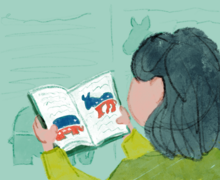Biden’s student loan relief plan is going to SCOTUS. What you need to know
Young-Bin Lee I Staff Photographer
As the Supreme Court begins hearing arguments about the student loan forgiveness plan, here's how it got there.
To support student journalism and the content you love, become a member of The Daily Orange today.
A Nov. 14 ruling concluded that President Joe Biden’s student-loan forgiveness program would cause states to suffer severe declines in tax revenue, a Court of Appeals then halted the plan indefinitely.
Of around 26 million people who applied to receive relief, debt payments for the 16 million approved have since been effectively stalled until the Court makes a decision, according to the White House. The U.S. Supreme Court refused to lift the ban, but agreed to hear oral arguments surrounding the case in February 2023. Here’s what you need to know about the program’s halt and the upcoming case.
What is Biden’s student loan forgiveness plan?
President Biden officially announced the program on Aug. 24 in a White House statement. At the time, the plan laid out that any person with federally-held student loans and an individual income of less than $125,000 could request up to $10,000 in debt relief, or $20,000 if they are Pell Grant recipients, by filling out an online form that first became available in October.
The form – which was set to remain open until the end of 2023 – is now closed, and has a notification on its landing page that the administration is working to overturn the court’s decision. The page also lists that anyone who already applied can now subscribe to the Department of Education email list and receive updates on whether they will receive their promised relief.
Biden announced the program in the wake of the COVID-19 pandemic and rising costs of attending college in the United States. Currently, nearly 43 million Americans owe a combined $1.6 trillion in federal student loans. From 1991 to 2021, tuition costs at private, nonprofit four-year schools have increased from an average of $19,360 to $38,070, according to the College Board.
Biden extended the student loan moratorium nine times – the most recent being on Nov. 22, amid the legal challenges – but stated that payments would now be due “no later” than June 30, 2023.
In the last election cycle, progressive political figures have called for a total cancellation of student debt, along with guaranteed tuition for public universities and any minority-serving institutions such as historically Black colleges and universities.
What do lawsuits against the relief program look like?
Legal challenges to the student-debt relief plan first started when a lawsuit filed on Sept. 29 by Missouri and five other Republican-led states claimed the program would hurt the states’ tax revenues, specifically mentioning the Missouri-based student-loan company MOHELA.
The involved states contend that because debt payments, including student loans, are often categorized as income, a federal student loan forgiveness plan has the potential to hurt tax revenues. More specifically, they argue that debt relief could cause income tax delivered to state governments to decrease and harm a given state’s operations.
MOHELA denied any involvement in the lawsuit after Congresswoman Cori Bush wrote an open letter calling out the organization.

Megan Thompson | Digital Design Director
In their initial dismissal of the case, district courts ruled that states could not rely in the proceedings on harm to an entity separate from them. Later, when the states then appealed the decision, Missouri’s 8th Circuit of Appeals ruled against the Biden administration. The ruling paused the program indefinitely and set it on course to undergo arguments at the Supreme Court.
What happens now?
The Supreme Court agreed to hear the case, but will not take immediate action and lift the 8th Appeals Court indefinite pause of the program. The Court is expected to begin hearing arguments starting in February, though the set date for relief was Jan. 1.
The White House issued a statement after the Supreme Court’s decision to hear the case, welcoming the Court and affirming the legality of the program.
“This program is necessary to help over 40 million eligible Americans struggling under the burden of student loan debt recover from the pandemic and move forward with their lives,” Press Secretary Karine Jean-Pierre said in the statement. “The program is also legal, supported by careful analysis from administration lawyers. President Biden will keep fighting against efforts to rob middle class families of the relief they need and deserve.”

Published on December 4, 2022 at 11:17 pm
Contact Grace: gdkatz@syr.edu





